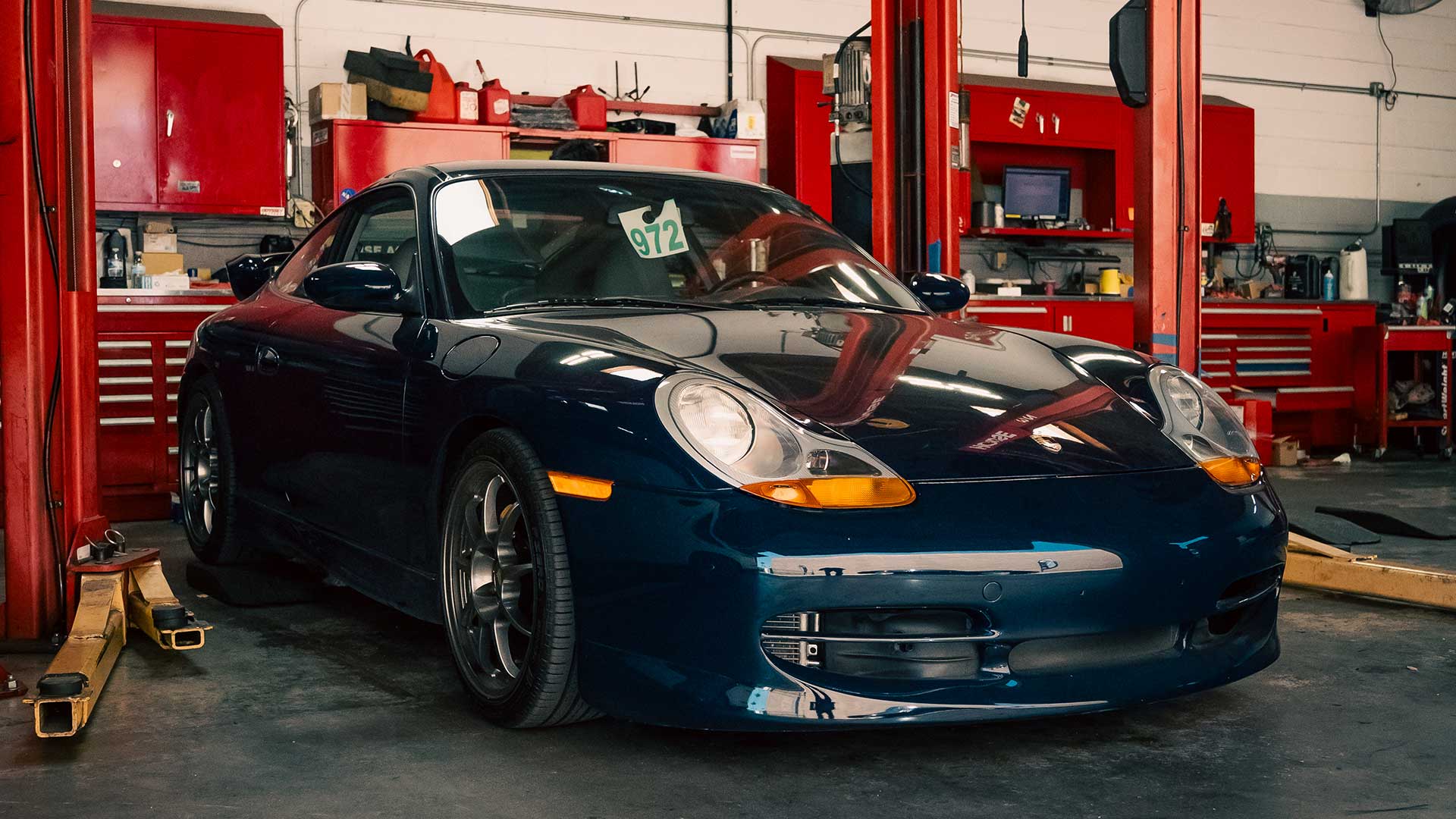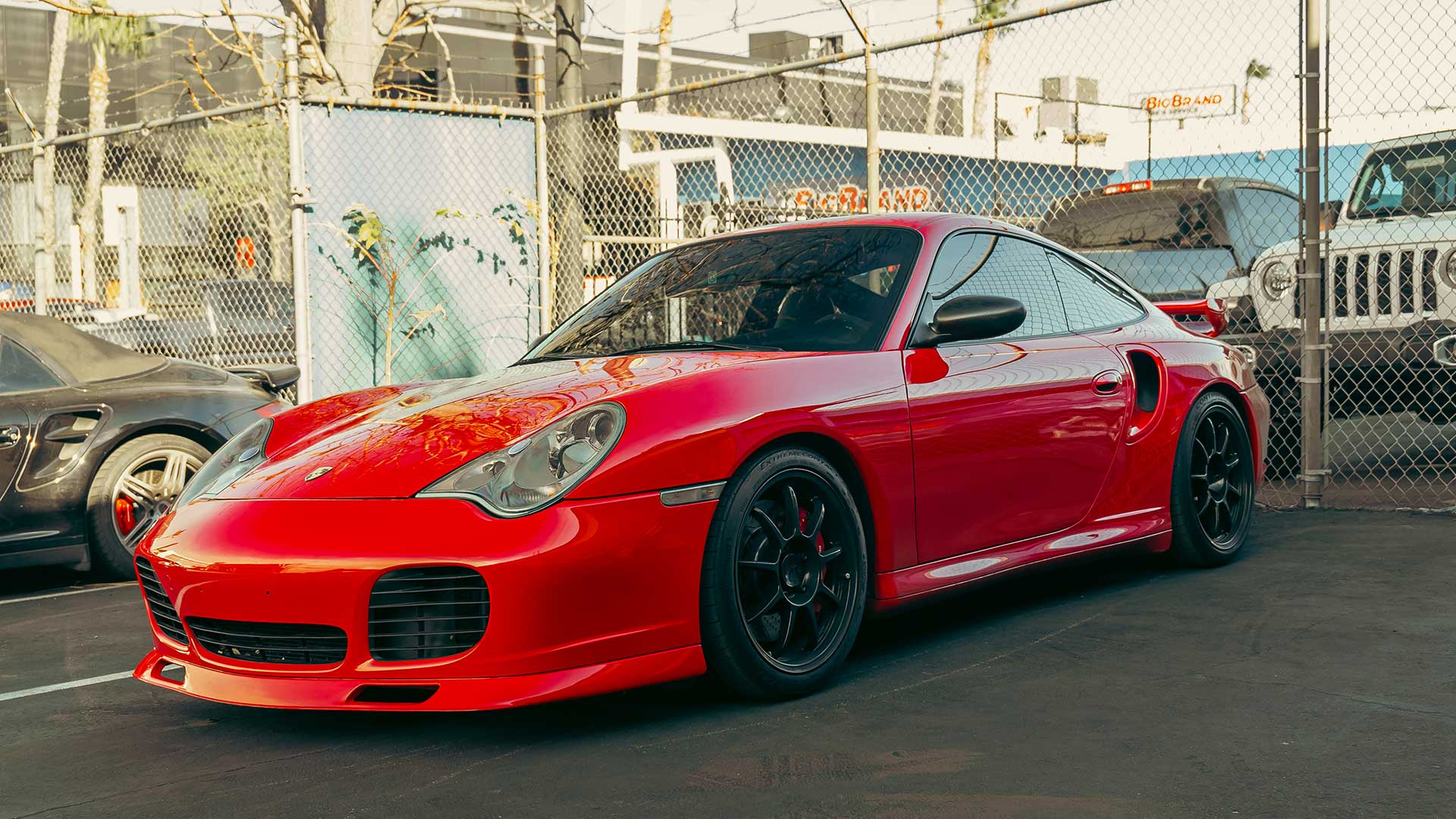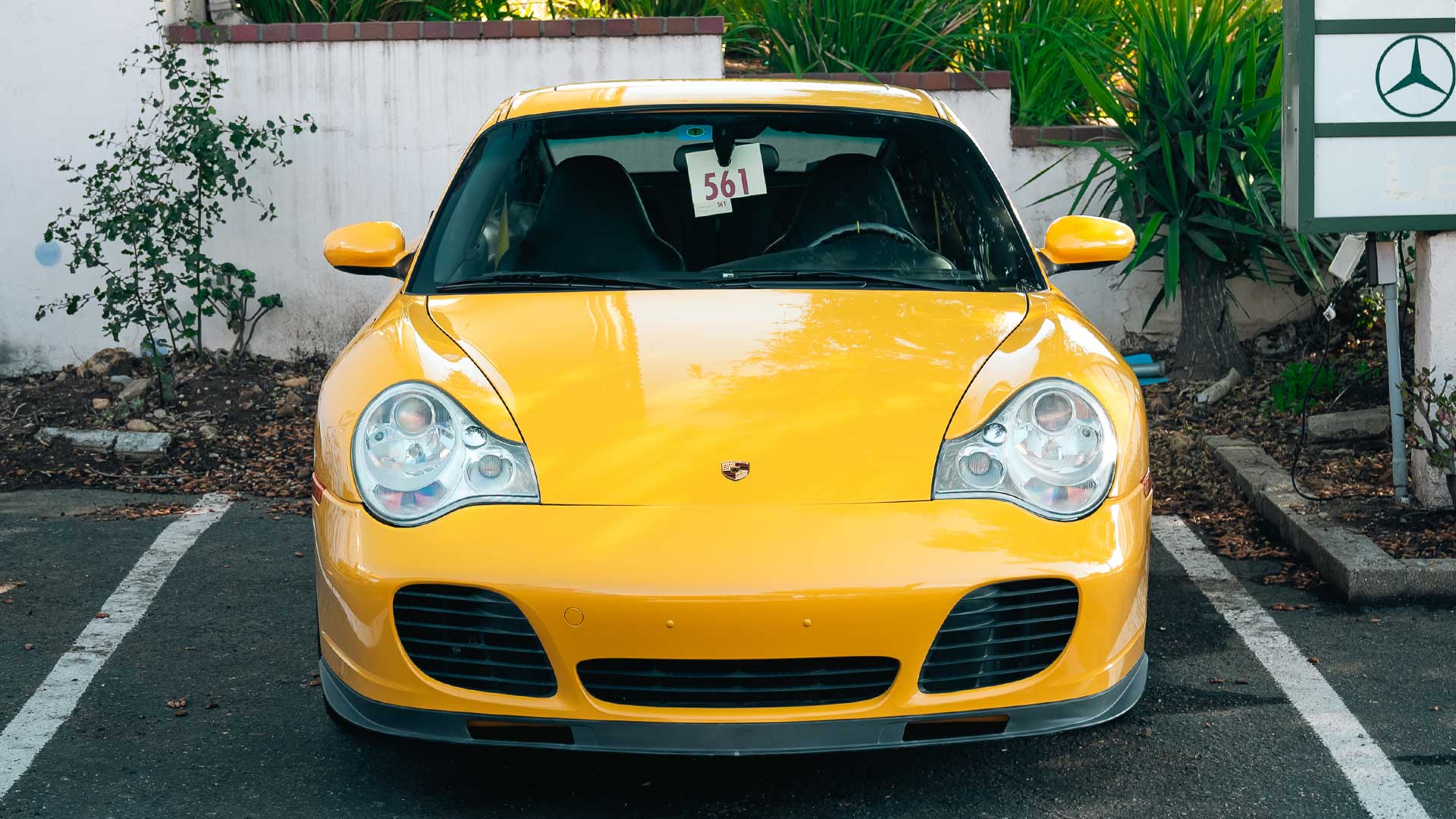The Ultimate 996 Porsche 911 Guide: Fried Eggs & Future Classics
Porsche’s 996 generation (1997–2005) represented the biggest gamble in 911 history.
Air cooling disappeared, replaced by water jackets and radiators. Enthusiasts cried foul, calling it soulless and Boxster-like, while pragmatists applauded the move that kept the company alive.
Two decades later, the same cars once scorned for runny-egg headlights are catching fire in the market. Rising values, an intoxicating mix of analog feel and modern reliability, and a driving experience that still defines Porsche have transformed the 996 into one of the most intriguing ways into 911 ownership.
996.1 (1998–2001)
The first wave of water-cooled 911s came armed with the 3.4-liter M96/01 flat-six, a motor good for 296 horsepower and 258 lb-ft of torque. In period testing, the Carrera cracked 0–60 mph in around five seconds, a figure that cemented its modern performance credentials while keeping the traditional 911 silhouette alive.
Controversy swirled around the so-called “fried egg” headlights, shared with the 986 Boxster, but beneath the styling debate lived a car that felt sharper and more approachable than the edgy 993 it replaced. The cable-operated throttle offered mechanical honesty, steering feedback was laser precise, and the chassis balance rewarded commitment.
Step inside, and the story shifted. Porsche had shaved costs, leaving a four-spoke wheel and no glovebox as reminders that the accountants had been in the room. Materials quality also drew criticism, though the underlying driving experience carried enough magic to overshadow plastic trim and missing storage.

996.2 (2002–2005)
The facelift arrived with more than just a nip and tuck. Porsche engineers massaged the flat-six to 3.6 liters, giving it 320 horsepower and 273 lb-ft of torque. That bump brought sub-five-second sprints to sixty and a more flexible powerband that made the car friendlier in everyday driving.
Turbo-inspired headlights erased some of the criticism aimed at the earlier cars, while the cabin finally felt worthy of a six-figure sports car. A three-spoke wheel, added glovebox, and upgraded trim made it feel less spartan and more refined.
Underneath, the body grew a touch wider and the chassis gained noticeable stiffness. Electronic throttle replaced the mechanical cable, dividing opinion among purists. On the road, the 996.2 came across as more mature—composed at high speeds, with handling that felt secure and polished.
For some, that polish dulled the immediacy of the earlier cars. For others, it marked the moment the water-cooled 911 came into its own.

Complete Model Lineup & Specifications
Carrera (1999–2004)
Available as coupe, cabriolet, and later targa, the base Carrera delivered the essence of the 996 experience. Early cars featured the 3.4L engine, while later examples adopted the 3.6L. Narrow bodywork kept proportions trim and handling nimble.
Carrera 4 and 4S (1999–2005)
All-wheel drive variants provided added security in poor weather without dulling the experience. The 996.2 Carrera 4S became a fan favorite, borrowing the wide-body shell, brakes, and suspension of the Turbo but keeping naturally aspirated power . Many enthusiasts consider it the sweet spot of the range for looks and everyday usability.
Turbo (2002–2005)
The 996 Turbo revived Porsche’s use of the race-bred Mezger engine. With 415 horsepower and AWD traction, it delivered supercar performance at a fraction of the cost of rivals . Even today, the 996 Turbo remains one of the best performance bargains in the 911 family.
GT3 (1999–2005)
Offered in both 996.1 and 996.2 forms, the GT3 reintroduced the hardcore, naturally aspirated Mezger motor to road cars. It featured lighter weight, track-focused suspension, and raw feedback that cemented its place as a modern classic.
GT3 RS (2004)
A homologation special limited in numbers, the RS combined lightweight panels, stiffened chassis tuning, and a 381-hp Mezger flat-six . Today it ranks among the most collectible 996 variants.
GT2 (2002–2005)
Known as the widowmaker, the GT2 sent 477 turbocharged horses to the rear wheels only. With no stability control, it demanded skill and courage, standing as one of the wildest modern 911s.

Common 995 Issues: What You Need To Know
HOUSE Automotive’s team of Porsche experts has been servicing, maintaining, and restoring 911s, such as the 996, for years.
Our experience with these models makes us a trusted resource for owners navigating the all-important pre-purchase inspection as well as long-term care. A proper inspection can highlight issues before they become financial disasters, giving buyers leverage and peace of mind.
If you’re in the market for a 996, here’s everything you need to be aware of to make an informed decision.
IMS Bearing
The intermediate shaft bearing in M96 engines is the most notorious failure point. If it goes, the engine usually self-destructs. Failure rates have been documented around 8–10% for single-row bearings and 1% for dual-row. Many cars have been retrofitted with aftermarket solutions, and buyers should verify service records.
Rear Main Seal (RMS)
Leaking RMS is a well-documented issue. While not catastrophic, it often coincides with clutch service. Budget accordingly, as it’s a labor-intensive fix.
M96 Engine Issues
Beyond IMS, bore scoring and coolant leaks are risks. Engines with consistent oil change history and preventative work fare much better. Proactive maintenance is essential for longevity.
Cooling System
Front-mounted radiators and coolant pipes collect debris, leading to corrosion and leaks. Cars driven in dirty or wet climates are especially vulnerable.
Clutch and Flywheel
A worn clutch or dual-mass flywheel replacement is a costly repair. Test drive for smooth engagement and listen for chatter or slippage.
Suspension Components
Worn dampers and tired control arms make the car feel loose. Upgraded aftermarket options often improve performance beyond stock.
Electrical Gremlins
Window regulators, ignition switches, and convertible tops often fail. Parts remain widely available, and fixes are straightforward for specialists.
Interior Wear and Tear
Wear shows in the driver’s seat bolster, soft-touch plastics, and dashboards prone to cracking under sun exposure. Refurbishment services are common.
996 Maintenance Considerations
Major services occur every four years or 40,000 miles, including oil changes, fluid checks, belt replacements, and inspections.
Costs range from several thousand dollars, depending on whether specialist or dealer work is performed. Independent Porsche shops like HOUSE Automotive often deliver equal or better quality at lower cost.
Preventative maintenance, particularly IMS retrofits, cooling system service, and suspension refreshes, protects against the most expensive failures. Fortunately, parts availability remains strong, thanks to Porsche’s support and a robust aftermarket.
Performance & Driving Experience
996.1 Personality For Days
Engine
The 3.4-liter flat-six may not look like much on paper today, but it’s a jewel when driven hard. With 296 horsepower on tap, a 7,200 rpm redline, and less than 3,000 pounds to push around, the 996.1 feels light on its feet. The throttle cable offers an old-school, mechanical honesty that rewards subtle inputs and punishes those that are lazy.
Handling
Hydraulic steering delivers chatter and weight that remind you why Porsche steering remains the benchmark. The lighter chassis lets the car change direction with immediacy, and while the rear weight bias is still present, it’s friendlier and less intimidating than the 993 it replaced.
Street Character
Around town, the early 996 is surprisingly livable. The ride is firm but not punishing, visibility is excellent, and the ergonomics are modern enough to use daily. Yet every trip, even a run for groceries, feels like an event because of the responsiveness baked into the car.
Track Character
On a road course, the 996.1 reveals its true personality. It rotates willingly under braking, dives into corners with sharp front-end bite, and rewards momentum driving. For drivers who enjoy a car that talks back, the 996.1 delivers a rawness the later facelift smooths away.
996.2 Refinement With Immediacy
Engine
The 3.6-liter M96/03 bumped power to 320 horsepower and 273 lb-ft, but more importantly, spread torque across a wider band. Acceleration feels easier, with usable grunt available well below redline. It’s quicker in real-world driving, and sub-five-second runs to 60 mph were headline numbers when new.
Handling
A stiffer chassis gave the 996.2 more composure, especially in high-speed sweepers. The switch to electronic throttle brought precision but lost some of the tactile intimacy purists loved in the earlier cars. Still, the overall package feels balanced and secure.
Street Character
The facelift transformed the Carrera into a more rounded machine. Cabin upgrades, a glovebox, and better materials finally made it feel like a premium product. On the road it’s more refined, quieter, and more comfortable, making it a better daily driver without erasing the Porsche DNA.
Track Character
At the limit, the 996.2 trades some of the early car’s playfulness for grip and control. It’s less prone to being unsettled, more planted through fast transitions, and forgiving enough for less experienced drivers. For some, that meant the 996 lost a touch of mischief; for others, it was proof Porsche had perfected the formula.
Investment & Value Perspective
Market Trends
For years, the 996 sat in the bargain basement of 911 ownership. Today, values are climbing, especially for well-maintained Carreras and anything Mezger-powered. Turbos and GT3s have surged, while Carrera 4S models are increasingly sought after for their Turbo-derived looks.
Future Outlook
Manual transmission cars, particularly coupes, appear best positioned for appreciation. Service records and IMS solutions carry more weight with buyers than mileage alone. Limited-production models like the GT3 RS and GT2 already command premium values, with no signs of slowing.
Ownership Experience
Daily Usability
Practicality separates the 996 from older 911s, making them an excellent choice for modern roads. Climate control works well, ergonomics are friendly, and fuel economy of around 20 mpg is achievable. With rear seats for children or bags and a frunk for luggage, the 996 proves surprisingly livable.
Community & Resources
Owners benefit from a vast network of support. Forums like Rennlist and 6SpeedOnline provide knowledge, while the Porsche Club of America offers social and track events. Independent specialists and parts suppliers make ownership manageable.
Choosing Your Perfect 996
Purists lean toward the lighter, rawer 996.1 with its mechanical throttle and playful character. Drivers after polish and presence gravitate to the 996.2 Carrera 4S, often considered one of the most handsome water-cooled 911s . Collectors with deeper pockets chase GT3s, Turbos, or the rare RS and GT2 before prices climb further.
Misunderstood at launch, the 996 has aged into one of the most rewarding entry points into the Porsche world. Sharp steering, plentiful performance, and a growing reputation now position it as the 911 that went from underdog to future classic.
Frequently Asked Questions: Porsche 996 911
The Intermediate Shaft (IMS) bearing is a sealed ball bearing that supports the intermediate shaft in the M96 engine. When this bearing fails, it can cause catastrophic engine damage including loss of camshaft timing, bent valves, and metal debris contamination. Models from 2000-2005 with single-row bearings have the highest failure rate at approximately 8-10%. At HOUSE Automotive, we recommend proactive IMS bearing replacement with upgraded solutions during preventative maintenance to avoid costly engine rebuilds.
The 996 Turbo, GT3, and GT2 are the most reliable variants because they use the Mezger engine, which doesn’t have the problematic IMS bearing found in standard Carrera models. These models feature a split-case design that’s effectively bulletproof. We particularly recommend the 2001-2004 Turbo models for clients seeking worry-free performance.
Annual maintenance costs typically range from $1,500-$2,000 for routine servicing and wear items. However, major preventative maintenance including IMS bearing replacement, RMS (rear main seal), AOS (air-oil separator), and water pump can cost $8,000-$10,000 upfront. At HOUSE Automotive, we help owners budget for these critical services to ensure 5-6 years of worry-free ownership after preventative work is completed.
We always recommend a comprehensive PPI that includes checking OBD fault codes, emissions monitor status, bore scoring analysis, coolant system condition, and suspension wear. Critical areas include the IMS bearing condition, rear main seal leaks, coolant expansion tank integrity, and DOT dates on tires. At HOUSE Automotive, we provide detailed PPIs that identify not just current issues but also projected maintenance needs over the next 2-3 years.
The 996 market has experienced appreciation over recent years, particularly for well-maintained examples and special variants like the Turbo and GT3. Base Carrera models remain affordable entry points starting around $20,000-$40,000, though cheaper examples typically require significant maintenance investment. While some market softening occurred in 2023-2024, the 996 is increasingly recognized as the last naturally aspirated, hydraulic-steering 911 generation, which positions it favorably for future collectibility.
The 996.1 (1999-2001) features a 3.4L M96 engine producing 296 hp, while the 996.2 (2002-2005) upgraded to a 3.6L engine with 320 hp. The 996.2 also introduced Targa body style, improved interior materials, revised headlight design on some models, and enhanced suspension components. Both generations share the same IMS bearing concerns, though 996.1 dual-row bearings statistically fail less frequently than 996.2 single-row bearings.
The 997 offers more modern styling, refined interior quality, improved engine reliability, and enhanced safety features. However, the 996 provides more raw, analog driving dynamics at a significantly lower entry price. At HOUSE Automotive, we guide buyers based on budget and priorities: the 996 is ideal for enthusiasts seeking pure driving experience and value, while the 997 suits those wanting modern refinement and reduced maintenance concerns.
Common 996 issues include coolant expansion tank failures, coolant pipe disconnections (especially on Turbos), CV axle wear, wheel bearing noise, suspension component wear, rear main seal leaks, and AOS failures. The cooling system requires attention as condensers, radiators, and plastic coolant lines deteriorate with age. We also frequently address brake pipe corrosion, clutch wear, and electrical issues in convertible tops on Cabriolet models.
Porsche recommends service intervals of 2 years or 20,000 miles, but we strongly advise annual servicing regardless of mileage. Oil changes should be performed annually using high-quality synthetic oil to extend engine component life. Critical maintenance includes spark plugs and coils every 5 years, brake fluid every 2 years, and coolant system inspection annually. Preventative replacement of wear items before failure significantly reduces long-term ownership costs.
Yes, the 996 makes an excellent daily driver when properly maintained. The Turbo models are particularly well-suited for daily use due to Mezger engine reliability. However, factor in higher fuel costs, premium maintenance expenses, and the need for proper storage during winter months in cold climates. At HOUSE Automotive, we help clients establish maintenance schedules that support daily driving without compromising reliability.
Bore scoring is cylinder wall damage caused by inadequate lubrication, typically appearing as vertical scratches on cylinder walls. It’s more common in engines that experience frequent heat cycles, short trips, or inadequate oil change intervals. Detection requires borescope inspection during a PPI or major service. Using high-quality synthetic oil and changing it annually rather than following extended Porsche intervals helps prevent bore scoring.
High-mileage 996s can be excellent purchases if they have comprehensive service records and have received proper preventative maintenance. We prefer higher-mileage cars with documented IMS bearing replacement over low-mileage examples with unknown bearing condition. Cars driven regularly typically have fewer issues than garage-stored vehicles with sporadic use. At HOUSE Automotive, we evaluate each car individually rather than using mileage as the sole determining factor.
The 996 Turbo (2001-2005) and GT3 (2004-2005) are the most desirable variants due to Mezger engine reliability, exceptional performance, and strong value retention. The 996 Turbo offers twin-turbo performance with daily drivability, while the GT3 provides track-focused capability with naturally aspirated response. Carrera 4S models with wide-body styling and upgraded brakes also command premium pricing. Limited production models like the GT2 are increasingly collectible.
The 996 represents a strategic entry point into Porsche ownership rather than a traditional investment vehicle. Turbo and GT3 variants have shown steady appreciation and are likely to continue trending upward. Base Carrera models remain plentiful, which limits dramatic appreciation potential, but well-maintained examples are stabilizing in value. At HOUSE Automotive, we position the 996 as an affordable way to experience authentic Porsche driving dynamics with appreciation potential as a bonus.
Essential preventative upgrades include IMS bearing replacement, coolant line pinning (Turbos), upgraded diverter valves (Turbos), and suspension refresh with quality components. Performance modifications should maintain OEM+ philosophy to preserve reliability and value. We recommend addressing all maintenance deficiencies before considering power modifications. Common upgrades include exhaust systems, ECU tuning, brake pad compounds, and lightweight wheels.
